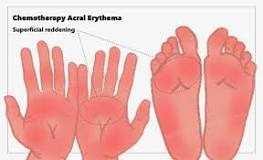Kanser tedavi gören hastalarda el ve ayak lezyonları için diclofenac jel
Kanser tedavi gören hastalarda el ve ayak lezyonları için diclofenac jel
Kanser nedeniyle tedavi gören hastaların önemli bir kısmında el ve ayaklarda soyulma, parmak ve tırnak diplerinde ağrılı cilt lekeleri oluşur.
Yeni yapılan bir çalışma ucuz ve ülkemizde de kolay bulunan bir jel kullanımı ile bu hastaların hayat kalitesini azaltan cilt lezyonlarını önemli oranda azaltabilir.
Onkoloji alanında önemli bir yere sahip Journal of Clinical Oncology dergisinde çıkan bir makale el-ayak sendromu yaşayan hastalar için basit bir yöntem ile önemli oranda başarı elde edilebileceğini gösterdi.
Daha önceki pre-klinik çalışmalar, kanser tedavisi gören hastalarda, el-ayak sendromunun görülme sebebi, inflamasyona sekonder artmış COX-2 aktivitesi olduğu biliniyordu. Selektif COX-2 inhibitörü Celecoxib ile başarılı sonuçlar alınmıştı. Fakat bu ilacın ciddi kardiyak yan etkileri olması nedeniyle rutin kullanımda kaldırılması nedeniyle yeni arayışlar içine girildi.
Kanser hastalarında yaygın kullanılan capecitabin adlı oral kemoterapi ajan ile önemli oranda el-ayak sendromu görülmektedir.
Bu çalışma, Capecitabin başlanan hastalarda tedavi süresince, el-ayak içine ve sırt bölgelerine günde iki kez diclofenac jel sürülmesi durumunda, el-ayak sendromunun çok önemli oranda azaldığı saptanmıştır.
Diclofenac jel ülkemizde farklı isimlerde mevcut olarak bulunmaktadır.
Bu çalışma capecitabin alan hastalarda yapılmış ve başarılı sonuç elde edilmiştir. Günümüzde oral alınan hedefe yönelik çok sayıda ilaç ile dirençli el ayak sendromu sorunları görülmektedir. Bu hastalarda faydası araştırılmakla beraber, ucuz, zararsız bu yöntem fayda gösterebilir.
Kaynak
Topical Diclofenac to Prevent Capecitabine-Associated Hand-Foot Syndrome
In an Indian single-center phase III trial (D-TORCH) reported in the Journal of Clinical Oncology, Santhosh et al found that topical diclofenac gel significantly reduced the risk of capecitabine-associated hand-foot syndrome vs placebo gel in patients with breast or gastrointestinal cancer who were receiving capecitabine-based treatment.
As stated by the investigators, “Hand-foot syndrome is a dose-limiting side effect of capecitabine. Celecoxib prevents hand-foot syndrome by inhibiting cyclooxygenase-2 (COX-2) that is upregulated because of the underlying associated inflammation. However, systemic side effects of celecoxib have limited routine prescription. Topical diclofenac inhibits COX-2 locally with minimal risk of systemic adverse events.”
Study Details
In the double-blind trial, 263 evaluable patients at the All India Institute of Medical Sciences, New Delhi, were randomly assigned between February 2021 and January 2023 to receive topical diclofenac gel (n = 130) or placebo gel (n = 134). Patients applied gel on the palmar and dorsal surfaces of both hands twice daily for 12 weeks starting concurrently with capecitabine treatment and during four cycles of capecitabine treatment. The primary endpoint was the incidence of grade 2 or 3 hand-foot syndrome at 12 weeks.
Key Findings
At 12 weeks, grade 2 or 3 hand-foot syndrome was observed in 5 patients (3.8%) in the diclofenac group vs 20 (15%) in the placebo group (absolute difference = 11.2%, 95% confidence interval [CI] = 4.3%–18.1%, P = .003).
Grade 1 to 3 hand-foot syndrome was observed in 6.1% vs 18.1% of patients (absolute difference = 11.9%, 95% CI = 4.1%–19.6%). Grade 2 and grade 3 hand-foot syndrome was observed in 1.5% and 2.3% of patients in the diclofenac group vs 9.8% and 5.3% of the placebo group, respectively.
Capecitabine dose reductions due to hand-foot syndrome were required in 3.8% vs 13.5% of patients (absolute difference = 9.7%, 95% CI = 3.0%–16.4%). No discontinuations of capecitabine occurred due to adverse events. Grade 3 adverse events occurred in 11.5% vs 13.5% of patients, mainly diarrhea in both groups.
The investigators concluded, “Topical diclofenac prevented hand-foot syndrome in patients receiving capecitabine. This trial supports the use of topical diclofenac to prevent capecitabine-associated hand-foot syndrome.”
Atul Batra, MD, DM, of the Department of Medical Oncology, BRAIRCH, AIIMS, New Delhi, is the corresponding author for the Journal of Clinical Oncology article.

